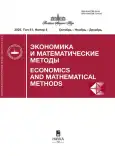This article analyzes the dependence of stock index dynamics on two types of factors — objective and subjective — which are understood, on the one hand, the dynamics of economic development, and, on the other hand, the activities of various stock market participants, affecting both the dynamics of the entire stock market and the values of stock indices. At the beginning of the article, the structure of the ratios of these factors is considered, and a summary of the content of the article is given. It is assumed that the main trend in the dynamics of the stock index, represented by the regression model, characterizes the results of objective factors, and deviations from it — subjective factors. After reviewing the works devoted to the construction of regression models for various stock indexes, a brief description of the history of the creation of the most famous stock index, the Dow–Jones index, is given. Based on the dynamics of this index for 1897–2024, regression models describing its main trend are built and the deviations of the index from this trend are analyzed. It is assumed that this trend depends on the objective characteristics of economic development, and deviations from it depend on the influence of subjective factors. It is shown that the main reasons for these deviations are incorrect time and intensity changes in the list of companies for which it is calculated, made by the managers of the index. This is interpreted as the influence of such a subjective factor as the “human factor” on the dynamics of this index. The level and significance of these deviations are further assessed against the background of the dynamics of US GDP, and it is shown that although in some periods of time the “human factor” deviates the dynamics of the index from the dynamics of US GDP, in general, the dynamics of the US economy has some “attractive force” for the dynamics of the Dow–Jones index. In conclusion, it is noted that when constructing models of stock indices, it is necessary to take into account the specific features of their structure, including the principles of changing their lists, the role of coefficients in the formulas for calculating these indices, and their other characteristics.
 5-17
5-17


 18-28
18-28


 29-43
29-43


 44-57
44-57


 58-72
58-72


 73-85
73-85


 86-97
86-97


 98-110
98-110


 111-125
111-125


 126-126
126-126











